Is it wrong for a robot to do your homework?
You’ve got an essay due in 12 hours, you’ve put it o until the last minute, now here you are with 20 readings to do, a blank page and an inescapable feeling of dread.
You could drink a litre of co ee, skim through dozens of papers that read like instruction manuals and pound at your keyboard like your life depends on it, or….

You could punch a few prompts into ChatGPT and have your essay done in less than a minute.

The choice is yours.
It’s not an exaggeration to say the world —
post-secondary schools and beyond — has been changed by ChatGPT. AI researcher, professor and Western University’s chief digital information officer Mark Daley, says the program is “one of the most exciting creative tools ever developed by humanity.”






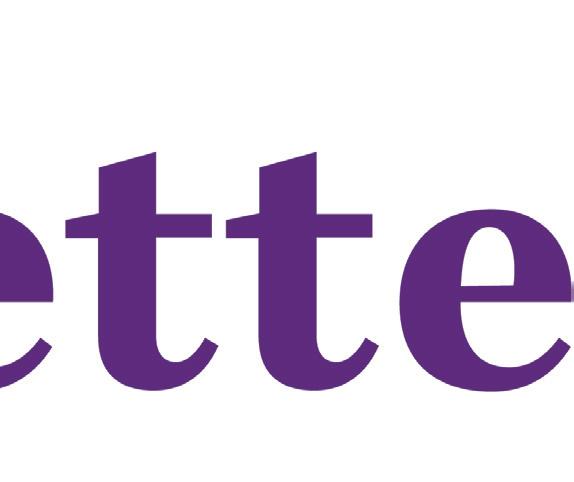
Daley expects in the next five years everyone will have an AI co-pilot like ChatGPT, for work and for daily life. In the context of academia, he expects professors will be weary of the technology, but believes — like with calculators and typewriters before — they will eventually come around.

“Some [professors] are going to react to radical new technologies with caution, which is fair, but I think in relatively short order, it'll be understood








that this is just a new technology,” Daley says. “What will overcome that caution is experience using the technology and seeing what it can do for themselves and their students.”

Daley has been a professor at Western for over 18 years, with artificial intelligence being his primary research focus. He has long studied language models like ChatGPT and says he was pleasantly surprised by how quickly a model of this sophistication was released. OpenAI, the company that developed ChatGPT, has created other natural language models, however, none of them compare to this latest release in functionality or popularity.
While post-secondary institutions around the world are hitting the panic button, trying to figure



out how to prevent students from using ChatGPT to cheat, Daley is encouraging his students to use the software.
In fact, Daley doesn’t even consider using the AI bot to write essays and answer homework problems cheating.
“This is not only not cheating, it's something I'd encourage my students to jump in, and start using this thing and figure out how to use it. Because this is going to be with you for the rest of your life.”
Western president Alan Shepard sees things di erently.
CONTINUED ON P4



JANUARY 26, 2023 VOLUME 116 ISSUE 6 since 1906 SPORTS NEWS Weldon Chatime
P4
P6 CULTURE
cool? Better BeReal P5 OPINION P7
opening
delayed until September
What
Western basketball, hockey and volleyball teams need to do heading into playo s
Western dance teams deserve varsity status
Wanna be
LUCAS ARENDER FEATURES EDITOR
REBECCA STREEF GAZETTE
VOLUME 116 , ISSU E 6
JANUARY 26, 2023
University Community Centre Rm. 263
Western University London, ON, CANADA N6A 3K7

Editorial editor@westerngazette.ca

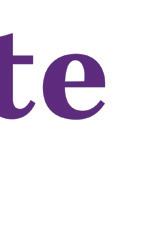
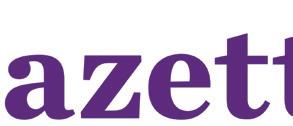
EDITOR-IN-CHIEF
HOPE MAHOOD
DEPUTY EDITOR
ALEX M C COMB
MANAGING EDITOR
SARAH WALLACE
COORDINATING EDITOR
(VIDEO AND FEATURES)
LUCAS ARENDER
COORDINATING EDITOR
(CULTURE AND SPORTS)
BIANCA COLLIA
ART DIRECTOR CASSANDRA KACZMARSKI
NEWS ANDY YANG
ESTELLA REN
ADSHAYAH SATHIASEELAN
SONIA PERSAUD
CULTURE
LAUREN MEDEIROS
CAT TANG
DANIELLE PAUL
SPORTS MILES BOLTON
KIERAN DROVER
RYAN GOODISON
Ombudsperson sees increased visits, ‘unique issues’ related to COVID-19
ADSHAYAH SATHIASEELAN NEWS EDITOR
OPINIONS
JORDAN BLOOM
HANNAH ALPER
STAFF REPORTERS
JESSICA KIM
VERONICA MACLEAN
COPY
ELIZABETH HART
SCOTT YUN HO
GRAPHICS REBECCA STREEF
KAT HERINE G UO
PHOTO
SOPHIE BOUQUILLON
VIDEO REBECCA BARTKIW
MADELEINE MCCOLL
ROMANO WATT
MINA AHMAD
SOCIAL MEDIA
ELIZABETH HART
PE’ER KRUT
CHIARA WALLACE
@UWOGAZETTE
@WESTERNGAZETTE
All articles, letters, photographs, graphics, illustrations and cartoons published in the Gazette, both in the newspaper and online versions, are the property of the Gazette. By submitting any such material to the Gazette for publication, you grant to the Gazette a non-exclusive, world-wide, royalty-free, irrevocable license to publish such material in perpetuity in any media, including but not limited to, the Gazette’s hard copy and online archives.
O ce of the Ombudsperson met with 1,120 students in the 2021-22 school year. Just over 100 students contacted the o ce with “unique issues” related to COVID-19, of which over three dozen were concerned with “fairness of vaccine mandates.”
Western’s
Thirty-eight Western University students approached the o ce after “they were not granted exemptions or received notification from Student Support and Case Management that they would be withdrawn if they did not upload their vaccine certificates,” read the ombudsperson’s annual report.

The O ce of the Ombudsperson, the university’s academic watchdog, serves as an impartial and confidential advisory body to help students navigate di cult situations, and listen to concerns about university-related situations.
The report’s data represents the period from Aug. 1, 2021 to July 31, 2022 when Western had a two-dose vaccine mandate. The university’s booster mandate was not announced until mid-August 2022 — after this data period ended.
According to the report, some students ignored the vaccine mandate until March 2022 and were withdrawn from the university at that time. The ombudsperson noted these students and their families were very upset but “had been treated fairly by the university. They had been provided notice that a decision would be made and a forum for requesting an exemption.”
Jennifer Meister, who has been the Western’s ombudsperson for 12 years, told the Gazette in an interview, that “for the most part, students were really understanding … the [vaccine] mandates didn’t have as much of an impact as the public’s thinking that it did.”
In total, 2.6 per cent of the undergraduate and graduate student population — Western and its affiliates have 43,352 full-time students — visited the ombudsperson. The statistic reflects 2.9 per cent of undergraduates and 1.8 per cent of graduate students using the service.
Western has one of the highest uses of its ombudsperson per capita among Canadian universities, according to the report.
The ombudsperson reported a 2.2 per cent increase in student visitors in the 2021–22 school year — a jump in 100 students from the previous year.
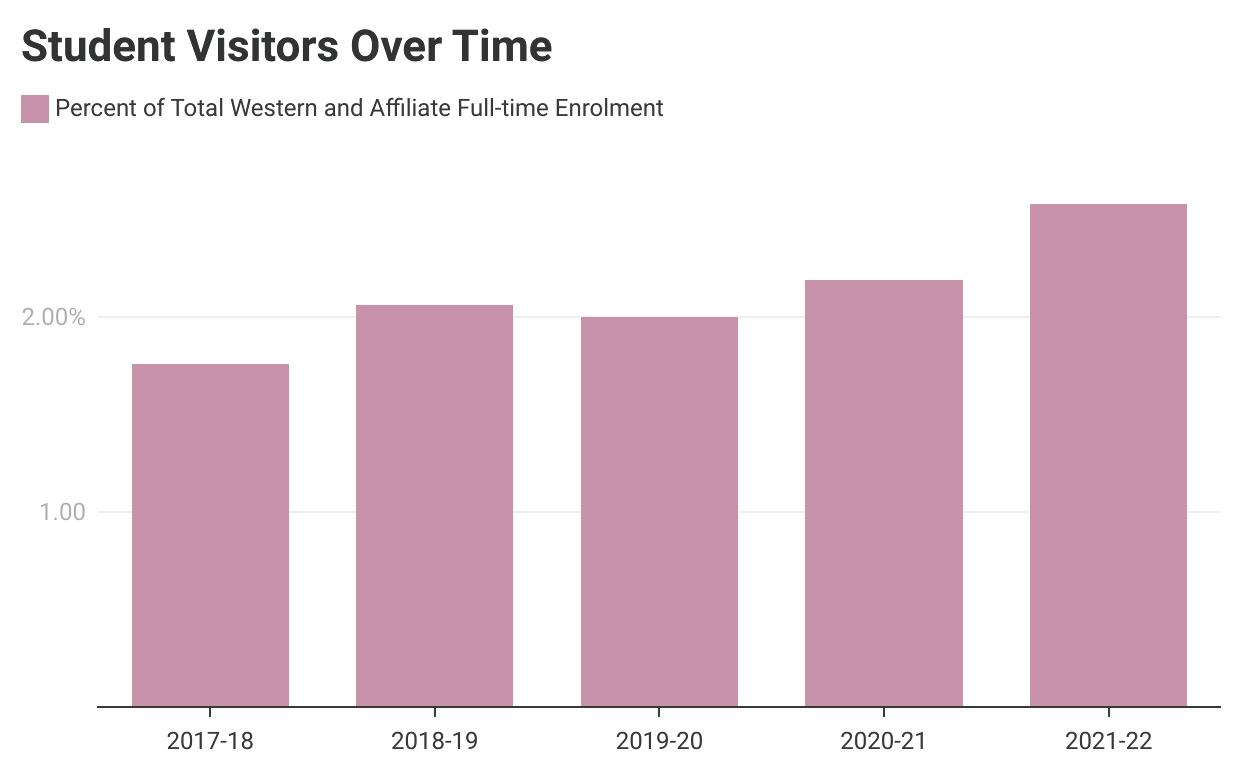
Meister said that with every generation of students, there’s “more at stake.” With the current rising living costs and stricter grade requirements
for post-graduate programs, she has noticed “more anxiety in students.”

Of the 862 undergraduate student concerns, 67 per cent were related to academics, including grade issues, program requirements and course management.

But Meister said the most complex situations she’s helped with are related to graduate and international students. Over half of all concerns raised by graduate students were academic-related.
The o ce also heard from 103 non-students, including faculty, administrators, sta , parents and alumni, who were primarily concerned about residence placement, equity and employment at the
university, as well as academics.
Meister said half of their o ce’s funding comes from a student fee titled “Academic Support” that charges $13.55 per student, and half comes from the university.
“This is a service that you’re paying for, so use us,” added Meister.


In the report, Meister said her o ce is e cient in responding to inquiries within 24 hours, even on weekends.
“We’re human beings first,” said Meister. “So, we really feel bad for some students when things happen. It’s not just looking at the policies and processes, but also relational fairness.”
Students can now apply for a one-time $500 rent top-up
SONIA PERSAUD NEWS EDITOR
Western students can now apply to receive a $500 rent top-up from the federal government based on their 2021 income.
Applications for the one-time top-up to the Canada Housing Benefit will close March 31 and can be accessed through the Canada Revenue Agency’s MyAccount service.

To be eligible, students must have had an adjusted net income of $20,000 or less for individuals or $35,000 or less for families. Their rent must also be more than 30 per cent of their 2021 income.
Students are considered individuals unless they are married or living common-law, received a Canada Child Benefit for a child under 18 years of age or claimed a deduction on their 2021 tax return for certain family members.
Students must also be at least 15 years old as of Dec. 1, 2022, have Canada as their principal residence, be a Canadian resident for tax purposes and
have filed their 2021 tax return.
When applying, individuals must state their principal residence addresses in Canada in 2022, total rent paid in 2022 for these residences and the name and contact of the people to whom the rent was paid.
This rent top-up comes as part of an agreement struck in March 2022 between the Liberal Party of Canada and the New Democratic Party.
The agreement saw the Liberals promise support for key NDP initiatives in exchange for NDP support on other issues, such as budgetary matters.
Canada’s new dental benefit for children under 12, announced last month at Western University, is also a part of this agreement.



The Liberal-NDP agreement says the Canada Housing Benefit top-up will be “renewed in coming years if cost of living challenges remain.”
Rent in London has increased by 36 per cent over the past year — the highest increase in Canada.
As of November 2022, the average one-bedroom apartment is now going for $1,818 per month and a
two-bedroom for $2,161. CBC News reported Monday students say they are struggling to find apartments under $1,000.
Simultaneously, Western students report feeling the e ects of inflation as the inflation rate hit 6.3 per cent year-over-year in December 2022.
Send us an email at managing@westerngazette.ca THIS COULD BE YOU! Western University’s o cial student newspaper since 1906 WESTERNGAZETTE.CA @UWOGAZETTE EDITORIAL SUPPORT MANAGER DAN BROWN GAZETTE CONTRIB UTORS LANEY ARMSTRONG MAREK BROOKING RACHEL FEIGENBAUM MASON LYN SHANSHAN MA-ZHANG CAMILLE SEYRAT SOPHIE SMITH ALLISON WANG NEWS | P2
/ WESTERNGAZETTE /UWOGAZETTE / WESTERNGAZETTE
KATHERINE GUO GAZETTE
Why does the USC election cost over $30,000?
ADSHAYAH SATHIASEELAN NEWS EDITOR
Jan. 23 was the first day of USC election campaigning, and the council has allocated over $30,000 to cover the costs — but what is that money going towards?
The $31,500 in the 2022-23 budget is earmarked to cover the costs associated with operating the elections, including subsidies, referendum and elections programs.
“This budget was approved by last year's Council … exact costs cannot be guaranteed at this point, but the budget gives the Elections Governance Committee guidelines to follow,” said Ethan Biswurm, the University Students’ Council vice-president of governance and finance, in a statement to the Gazette
Of the $31,500, the USC allocates $14,000 to subsidies, which includes reimbursement for candidate campaign costs.
“This accounts for half the budget, and ensures there are no financial barriers to running,” said Biswurm. The USC tries to estimate how many candidates will be running for each position, but budgets “for bu er since this number fluctuates every year.”
Candidates can receive reimbursement up to a maximum of the respective spending limits for their role, provided their expenses are determined to be eligible. Candidates can only be reimbursed for items directly related to their campaign, for which they provide original receipts.
This year, USC presidential candidates have
a spending limit of $1,500, faculty presidential candidates have a spending limit of $200 and divisional candidates, including faculty councillors, University Senate and Board of Governors representatives, have a spending limit of $100.
The Elections Governance Committee Campaign Finance Procedure requires candidates to submit a list of their expenses and contributions using the expense tracking sheet provided by the EGC to receive reimbursement. Candidates must submit the completed Expense Tracking sheet and documentation to the EGC for review.
The USC also provides interest-free loans to candidates that must be repaid within 30 business days from the close of balloting. Candidates seeking a loan may apply to the USC managing director of Financial and Corporate Resources.
The rest of the budget allocates $4,500 for referendums, $8,000 to elections programs and $5,000 to run the online nomination form. Campaign costs associated with running an educational campaign in the case of a referendum falls under the first category.

This year, the USC will hold a referendum on whether to add a permanent telehealth service, myVirtualCare to its student services, at an added cost in student ancillary fees.
The $8,000 budgeted towards elections program includes costs to run campaign school, elections results night and other elections-related events. This amount is an increase from the $6,700 budgeted for the 2021-22 school year.
The costs to operate and host the online voting portal for elections falls under the online nomina-
USC to hold referendum for virtual healthcare service
MAREK BROOKING CONTRIBUTOR
The USC will hold a referendum in the winter semester on whether to add a permanent telehealth service to USC’s student health plan, PurpleCare.

Council approved the referendum at its Nov. 23 meeting. A University Students’ Council referendum is a vote the whole student body participates in, usually covering issues a ecting the mandatory ancillary fees that fund student services. This is the first referendum the USC has held in five years.
The referendum will ask if students want myVirtualCare — the USC’s temporary telehealth program added in response to the COVID-19 pandemic — to be a permanent service. The question will be attached to this winter’s USC election ballot.
The myVirtualCare program gives students 24hour access to licensed doctors, nurses and other healthcare professionals through a virtual setting.
Making the service permanent will add $44.07 to student ancillary fees — which are charged in addition to tuition to fund student services. The amount would be billed separately from existing student health plans and the collected funds will be put into
the PurpleCare Trust.


The charge would put total student ancillary fees over $1,000.
At Western University, the results of any referendum are only binding if a minimum of 20 per cent of the student body votes. Historically, USC elections' voter turnout fluctuates around 20 per cent, meaning no referendum is a sure thing.
Social Science councillor Sofia Ouslis, who proposed the referendum in council, said she hopes making myVirtualCare permanent would give students better access to healthcare services.
“MyVirtualCare does not only address issues with demand but also accessibility which can be crucial for students,” said Ouslis in council.
Ouslis said in the council meeting that full-time undergraduate students would also have the option to opt-out of this new telehealth service from their student health plan early in the academic year.
The USC’s motion proposal acknowledged that adding this new telecare option may be problematic to many students who struggle to pay for necessary items. It was also acknowledged that some students may forget to opt out of the health plans already o ered by the USC.
tion form category. This year, $5,000 was allocated towards this budget category, an increase from the $4,500 budgeted for the 2021-22 school year.
According to Biswurm, this budget is adequate to run the election, and the full budgeted amount has been su cient in past years.
“This budget is a moving target, given how many factors need to be predicted — such as the number
of candidates and in-person components, but last year's Council felt that this would be appropriate to run a fully in-person election,” said Biswurm. Voting for USC president, faculty presidents, councillors and other roles will take place Feb. 7 to 10.
USC cements upper-year med sci students’ place in Science council elections
SONIA PERSAUD NEWS EDITOR ADSHAYAH SATHIASEELAN NEWS EDITOR
Upper-year medical science students can now o cially run, vote and nominate as Science students in USC elections, following a council vote on Jan. 17.
The University Students’ Council held an emergency meeting to specify that, for the purposes of USC elections, undergraduate neuroscience and medical science students are to be included in the Faculty of Science — not the Schulich School of Medicine and Dentistry.
The USC’s Elections Governance Committee initially announced, on Jan. 13, medical science and neuroscience students would be part of the Schulich Medicine constituency in the upcoming USC election. The decision was based on the fact that upper-year medical science students are registered in the Schulich school and USC policy requires that students run, vote and nominate in the faculty they are registered in.
The Science Students’ Council successfully appealed the EGC’s decision through the USC Appeals Board, with the board making their final decision on Jan. 16 — council’s emergency vote the next day solidified this ruling for future years.
In their decision, the Appeals Board cited the USC’s “vision statement” for Bylaw 2 — the USC policy that governs elections — which is to “maximize the opportunity for students to be involved in USC-governed elections at [Western University] as candidates, voters, and informed individuals.”
The Appeals Board concluded that, while the EGC’s decision was in line with the sections of Bylaw 2 which require students to run in vote in the faculty they are registered in, it was not consistent with the bylaw’s vision statement. Since the EGC is responsible for upholding all parts of Bylaw 2 — including its Vision and Principles, the Appeals
Board struck down the decision.
The USC’s vote on Jan. 17 brought the council’s policy fully in line with the Appeals Board’s decision.
At the USC meeting on Jan. 17, president Ethan Gardner said “everyone involved” had “done their job properly.”
“The EGC made the correct decision, the SSC made the correct decision for voicing student concerns and the Science president made a correct decision bringing it to council. And then we as council are also making the correct decision in having a vote today,” Gardner said.
Mohamed Aly, one of Schulich Medicine’s councillors, spoke in favour of amending the policy, saying third- and fourth-year students in BMSc would not be able to run for Schulich Medicine’s Hippocratic Council, and be left fully without representation if the rules weren’t changed.
Aly said this is based on the Hippocratic Council’s terms of reference, its bylaws and its elections, which run later in the spring and do not coincide with USC elections.
Hippocratic Council’s president Lina Ghattas and Science Students’ Council president Samdarsh Saroya also initially spoke out against the EGC’s decision on Jan. 14.
Saroya told his constituents the ruling, if left unchanged, would “considerably harm science student representation.” Currently, seven of the eight USC Science representatives, including Saroya, are medical science students.
At the Jan. 17 USC meeting, Saroya spoke in favour of the motion as well, adding this is an issue the SSC has been dealing with since the mid-2010s.
“The hope is that with this motion being passed, future science councils aren't going to have to deal with this issue anymore,” Saroya said. “Essentially we're just tying up all these loose ends once and for all.”

NEWS | P3
KATHERINE GUO GAZETTE
RACHEL FEIGENBAUM GAZETTE
Is it really wrong for a robot to do your homework?
CONTINUED FROM P1
“You're just cheating yourself, cheating the system and you're also cheating yourself of the struggle of like having to learn how to grapple with ideas, how to synthesize them, how to express them, how to be persuasive, all those critical things that you want to learn in university,” Shepard told the Gazette in an interview.
Shepard expects the software will ultimately change how professors assign work in courses where writing is the main form of assessment. He admits that he’s scared of its implications, nervously joking that eventually the computers won’t need us anymore.
While Shepard and Daley don’t see eye to eye on this, they find common ground in the belief that the software is far from a sure-fire shortcut to the Dean’s List.
“What I hear from people who have [used ChatGPT] is that it's good, It's not great. It can get you a C plus or a B minus but it's not going to be a sterling piece of work,” Shepard says.
“If you feed these large language models, sort of boring ideas, they give you back boring prose,” Daley says.
At least one Western student, however, seemed to have had a di erent experience. This student, who the Gazette is not identifying as they fear academic re-

percussions, relied heavily on ChatGPT to write one of his final exams.
He got a 93.
The student and his classmates spent the days before the exam venting in the class group chat, admitting to each other that none of them were ready for the exam. A couple of months ago, they might have been left to the wolves, but the December launch of ChatGPT turned out to be their saving grace.
“I was talking to a lot of people in the class, and a lot of people were saying they're going to use it. I [thought to myself] ‘I have a really low chance of anything negative happening here.’”
Ethically, the student said he was comfortable using the software for two reasons: the exam was open book and, having scoured the exam outline and academic policy for the course, found no mention of AI pilots or ChatGPT being prohibited.
“Even if I got accused of cheating, I have a very good argument that it was not banned,” he said.
He said he didn’t quite copy and paste the answers provided to him by ChatGPT but definitely used it as a crutch for understanding key concepts in the course and articulating them into coherent answers. Admittedly, his biggest concern was that his classmates, plugging in similar, if not identical, prompts would submit answers that were too close to his.
He shu ed a sentence here and there, changed a few words, and pulled o an A without raising any alarm bells.
The most popular plagiarism-detection software used by Western professors, TurnItIn, has developed a bot that it claims can identify text written by AI co-pilots like ChatGPT. The company says on their website: “we have technology that can detect AI-assisted writing and AI writing generated by tools such as ChatGPT.”
This is one avenue that Western and other universities could take — catch the “cheaters” and push students away from using the technology. Many Western courses already use TurnItIn to check for plagiarism, making this a simple and, if you take the company at its word, an e ective way of identifying AI generated text.
But as Daley says, the genie is out of the bottle, this technology is not going anywhere. He wonders why, if students are going to be using this technology for the rest of their lives, its use would be discouraged in an academic setting.
“People are going to adopt it, and we live in a free market economy so people who adopt it are going to be way more productive, and they're going to out compete those who don't,” Daley explains. “We're all going to have to adopt it anyway.”
He believes in order to train his stu-
dents to be successful in their careers and in their lives, he must expose them to every available resource that can enable success, especially ChatGPT.
I asked Daley, theoretically, if a student used ChatGPT to write their final exams last semester, would he consider that cheating. The scenario I gave him was, more or less, the same story told by the student who used the software on his final exam.
Daley paused, took a few seconds to think, and said no.
Third-year software engineering student Brayden Thompson sees ChatGPT as a double-edged sword. It has the potential to unlock academic potential but also the power to corrupt certain evaluations.
He has personally used the software as a study tool, asking the bot questions when he wanted clarification on a concept in class, not dissimilar to a digital TA that's at your beck and call. He also understands why the technology can be problematic to evaluations.
“I think it is an issue, but I think it's also something that professors are gonna have to adapt to,” he says.
Thompson says he feels that the value of the software is filling gaps in knowledge rather than replacing critical or creative thinking. He acknowledges that the software is not perfect and can still make mistakes, but says it's important
for students to grasp the basics of it as a study tool.
“I think every student should have an understanding of what it is and how to use it, because if something's missing in [your] notes, or something's missing in the solutions, or there's a gap in your knowledge that you're not able to fill, it's really easy way to figure it out.”
The e ectiveness of ChatGPT as an academic tool is clear, but the grey area of its implications on grades remains foggy. Similar to its adoption of remote proctoring services like Proctortrack during the pandemic, Western will always prioritize maintaining the integrity of its degree.
As Shepard explained, the university can't a ord to lose the weight of the Western crest imprinted on each diploma.
“We're always worried about academic integrity because for those who have academic integrity, and want their degree to matter, and not to be given away by people who are dishonest.”
Opinions are split and the stakes are high, but one thing is for certain. As Daley told me with a smile on his face:
“This is a really exciting time to be alive.”
Weldon Chatime opening delayed until September
ADSHAYAH SATHIASEELAN NEWS EDITOR
Chatime’s opening in the Weldon Library will be delayed until at least September due to staing shortages in Western Hospitality Services. The bubble tea shop was originally set to open in November 2022.
Although construction has finished, Weldon’s Chatime, located on the left side of the library entrance, is still closed o .
“Everyone wants it open right away, but [Hospitality Services] can’t get any sta ,” said Jennifer
Robinson, Western Libraries’ deputy chief librarian.
Hospitality Services said in a statement to the Gazette that they are “excited to be providing this new dining option, Chatime cafe, that will be open in the fall 2023.We are currently recruiting hospitality sta in a tight talent market to sta our many on-campus eateries.”
According to Robinson, September is the earliest students can expect to stand in line for boba.
Chatime’s delayed opening is the latest campus eatery to be a ected by ongoing sta ng shortages, with locations such as the Western Student Recreation Centre’s Booster Juice and the Social
Science Centre’s Tim Hortons closing down entirely. Some eateries have also seen reduced operating hours, such as the FoodHub food court in the University Community Centre and Lucy’s in Somerville House.
The UCC Booster Juice also temporarily closed earlier this month, and redeployed sta to the main floor Starbucks. According to Hospitality Services, Western will reopen the smoothie shop in February if it has enough sta .
Chatime is a global Taiwanese bubble tea chain with over 84 locations in Canada and 70 in Ontario, alone. There is one other Chatime location in London, near the Wonderland Road and Ox-

ford Street West intersection. Another location is currently under construction in Masonville Mall.
It is currently the world’s largest teahouse franchise.
Hospitality Services decided to open a Chatime after conducting a campus survey in summer 2020, receiving over 4,000 responses. Survey results found bubble tea was something “students wish to see on campus,” wrote Hospitality Services associate director Jacqueline Hassall and operations manager Craig Clifford in the Housing and Ancillary Services Employee Newsletter last summer.
Western OUAC applications rebound after major drop
ADSHAYAH SATHIASEELAN NEWS EDITOR
Western’s main campus saw a 2.9 per cent increase in Undergraduate 101 applications from Ontario secondary schools, a significant rise after a major downtick last year.
Western University’s main campus received 38,466 applications as of Jan. 14 — 1,070 more than January 2022. Applications to Western had previously been on the rise since 2015, with an average increase of three per cent per year and last year marked the first major drop.
Last year, Western’s statement in response to the application drop said “we know it has been a challenging year for the Western community and we’re continuing to examine what the application data means.” Fall 2021 saw reports circulate of sexual violence during Orientation Week and the death of first-year student Gabriel Neil, both just a few months before applications were due.
Most of the university’s a liate colleges made a significant recovery this year too — Huron University College saw a sharp 29.6 per cent increase in applications and Brescia University College went up 27 per cent. But King’s University College application numbers dropped 3.8 per cent.

Acting university registrar Lisa Latif emphasized Western has had strong enrolment numbers for many years
“Some fluctuation in application numbers is to be expected from year to year and we are pleased to see applications have increased this year,” said Latif. “One goal outlined in the university’s strategic plan is to expand student enrollment.”
The university is hoping to expand its student population to 50,000 by 2030, including undergraduate, graduate, postdoctoral and lifelong learners, according to Western’s strategic plan, Towards Western at 150. There are currently 36,904 students enrolled at Western for the 202122 academic year.
The Ontario Universities Application Centre reported the overall number of applications to Ontario universities rose 2.9 per cent this year.
Latif noted these statistics reflect applications at one point in time and do not include out-of-province, international or mature student applicants.
Among Western’s peer institutions, Ontario Tech University saw the greatest jump at 20.3 per cent, followed by Nippising University at 17.3 per cent, Wilfrid Laurier University at 13.6 per cent and Brock University at 13 per cent.
All U15 Group of Canadian Research Universities, with the exception of Western, saw a decrease in applications this cycle. The University of Ottawa saw the greatest decline at 5.6 per cent less than last year. McMaster University, Queen's University, the University of Toronto and the University of Waterloo all saw a slight decrease in applicants within one per cent.
Annual OUAC Application (101) to Western
NEWS | P4
ADSHAYAH SATHIASEELAN GAZETTE
Café hopping: Happiness
 LAUREN MEDEIROS CULTURE EDITOR
LAUREN MEDEIROS CULTURE EDITOR
Dessert before breakfast is welcomed at Happiness café, an uplifting space with a giant teddy bear, upbeat instrumental music and an endless supply of sweets.
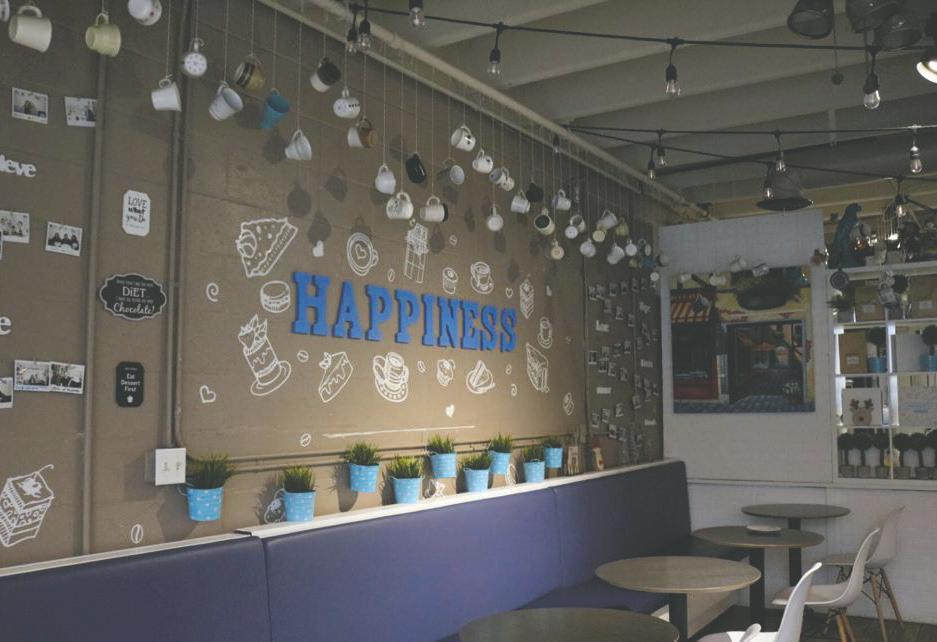
I almost forget that I’m in London with the view of Wellington Street blocked out from inside the café by sparkly silver streamers hung up on the windows.
Happiness is owned and operated by Olha Prytkova and her husband Anatolii, who both came from Ukraine in 2016. Luciana Velarde Baker is the full-time baker at the café and says the owners’ European background has been a big influence on their menu.
The café specialises in gourmet desserts, with a large variety of croissant flavours, but also o ers sandwiches like pesto caprese, smoked salmon and prosciutto with fig. Their glass display showcases a multitude of sweet treats, from chai tea donuts and pistachio macarons, to mocha and eggnog cheesecakes.

Velarde Baker points out the “cakes in the cup,” a Happiness original, which is available later in the day. They are exactly what they sound like — a layer of spongy cake placed at the bottom of a cup and topped with creamy icing and other decorations.
When she isn’t greeting customers and taking orders, Velarde Baker is in the back, baking desserts.
“I am always running around, but I love what I do,” she says.
There’s no better way to start a day than with a pastry, so I decide to try the multigrain croissant. If someone can make a really good croissant, they can pretty much do anything.
I pair the croissant with a cappuccino, Velarde Baker’s personal favourite, and it is unlike any co ee I’ve had before. It’s iced, made with almond milk and equal parts vanilla and hazelnut syrup.
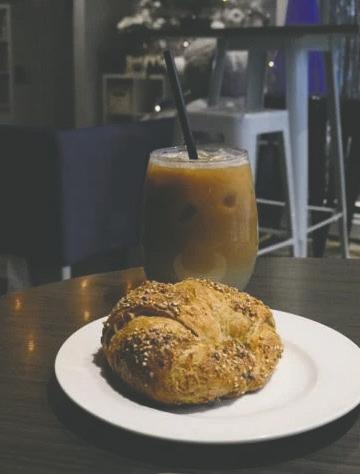
It’s sweeter than what I typically go for in a co ee drink, but the hazelnut is a pleasant twist to my ordinary latte.
With the first bite of the croissant, I’m sure it’s the greatest I’ve had in a while, and certainly the best I’ve had in London. It has the perfect crispy exterior — flaky, layered and buttery inside. I would pay any amount for a croissant like this, so the total order cost of just over $11 for the pastry and the cappuccino doesn’t bother me at all.
All of the drinks are served in glasses and mugs, and the food is served on real plates, bringing a homey feel to the small but welcoming café. Happiness doesn’t have wifi, so it’s less of a workplace and more a meeting place. A little bit of sugar and good company make Happiness the energizing environment it is.
“I’ve seen old friends come in and stay for hours,” says Velarde Baker. “It’s really nice for me to sit back and see.”
Happiness’ fun-loving vibe can provide visitors a brief escape from the cold and grey winter days bound to be ahead.
Wanna be cool? Then it's your time to BeReal
CAT TANG CULTURE EDITOR
Instagram and Snapchat were already years-long staples on Carly Smith’s phone, when she added a new app to the mix last summer: BeReal.
The fourth-year neuroscience student downloaded the app after it became popular with her friends at work.
“It seemed like a lot of fun to share what you were doing at that moment in the day,” says Smith. “I just wanted to be part of the fam.”
BeReal is a social media app founded in France that gained rapid popularity in 2022. The app was originally released in 2019 and has since reached approximately 20 million daily users.
The app emphasizes authenticity. BeReal encourages its users to post unpolished content at sporadic moments throughout the day. Its slogan? “Your friends. For real.”


The app’s main feature is a daily notification sent to all users simultaneously. The notification reminds users it’s “Time to BeReal,” signalling it’s time to post. Users are then allowed to capture a single set of photos — taken from the front and back camera of their phone — during this randomised two-minute interval throughout the day. Posts are then shared to their feed, and also display statistics such as how many times the user tried to take the photo, their location and how late they were posting. This aims to capture and share an unedited visual of what users are doing in real-time.
Or, in other words, when they’re being real.
Smith feels like the app did fulfil its intention of prioritising the present moment over staging photos — however, that doesn’t mean that the app is immune to staged photos.
“A lot of people still just wait seven hours to post the BeReal,” says Smith. “They wait until they’re doing something cool.”
BeReal has other measures on its app to entice


users to post. Users cannot see any of their friends' daily BeReals until they have uploaded their own.
For Zion Chan, a fourth-year philosophy student at Western University, it was his work in the technology industry, investing in early stage technology companies, that led him to download BeReal in summer 2021.
Chan says there was a strong sentiment among investors around 2021 — as COVID-19 restrictions began to loosen around the world — that there would be more opportunity for social media apps because people would be building new habits in a post-pandemic world.
“It’s kind of like a generational opportunity,” says Chan. “From the point of view of investors, it’s almost impossible to break the competitive advantages that Instagram, Tik Tok, traditional social media have.”
Luke Stark, a Faculty of Information and Media Studies professor, says that the social media landscape is changing. He cites Meta's 2022 layo s and decline in stock prices, as well as Twitter’s leadership changes, as examples of a transition in the technology industry.
“One point that some folks have made is that new social media platforms are increasingly seeking to develop smaller communities,” says Stark.
Unlike dominant social media apps like Instagram and TikTok, where users have the option to browse content without posting any, BeReal incentivizes its users to post every day.
“It’s easy to build the habit because there’s a call-action pattern,” says Chan. “You get the notification within the app, you [post] a bunch of times, build it and it becomes habitual for most people.”
Some users have described BeReal as a refreshing alternative to dominant social media apps like Instagram, which has been criticized for presenting an overly-edited version of people’s lives. BeReal has no photo filters or editing features, no advertising and does not display follower counts.
After BeReal skyrocketed in popularity last year,

other social media platforms have tried to replicate its features. Instagram launched a “dual camera” feature in July 2022 and started testing an “IG Candid Challenges” feature the following August.
TikTok launched TikTok Now, a concept similar to BeReal, in September 2022. Neither of these features became popular on Instagram or TikTok.
According to Chan, while the app does promote authenticity, it turns out that authenticity is actually very boring on a visual level.
“If you don’t give people control over when they can post, they can’t post the most exciting content,” says Chan. “Which means BeReal ends up seeing your friends just laying in bed every single day.”
Since downloading it last summer, Smith has
deleted BeReal. While she liked using the app as a daily visual scrapbook, not many of her friends outside of work were on it. She also found herself still trying to make her BeReals staged, losing the original purpose of the app.
Stark says that people use social media apps because of a need to engage with others, express themselves and share experiences — while BeReal supports that in a very regimented way, Stark is unsure whether it does enough to maintain longterm interest in the app.
“I think they’ll have to expand the use functions of the app,” says Stark. “But that potentially risks losing what novelty around authenticity it has — so there’s a bit of a paradox there.”
CULTURE | P5
LAUREN MEDEIROS GAZETTE Dessert display counter, Jan. 13, 2023.
LAUREN MEDEIROS GAZETTE Iced cappuccino and multigrain croissant at Happiness Cafe, Jan. 13, 2023.
LAUREN MEDEIROS GAZETTE Seating at Happiness Cafe, Jan. 13, 2023.
LAUREN MEDEIROS GAZETTE Receipt at Happiness Cafe, Jan. 13, 2023.
REBECCA STREEF GAZETTE
Opinion: London GO train a no-go for student riders

someone can spend the day in London and return to Toronto that same evening.
ADSHAYAH SATHIASEELAN NEWS EDITOR

Assomeone who has lived in the GTA my whole life and loved the GO train commute, I was disappointed when I recently took a trip from London to Toronto on their new route.
It's been one year since the Ontario government expanded GO train service to southwestern Ontario with daily weekday trips between London and Toronto through a pilot project with Metrolinx.
The route has one direct trip from London to Toronto at the crack of dawn — 5:14 a.m. to be exact — ending at 9:13 a.m., and one return trip leaving at 4:19 p.m. and reaching London at 8:19 p.m.. These timings are not convenient for Western students — or really anyone.
The early morning trip to Toronto and late night return to London also means there is no trip where
Most London Transit Commission bus routes don’t operate before 6 a.m.. Unless you’re willing to expense an Uber or live close enough to the London VIA Rail station to walk before the sun rises, this concern diminishes the benefit of taking this trip and might even cost you more.
As students, we typically visit Toronto for special events like music concerts or Raptors games, or to visit friends and family on the weekends. Limiting the train to weekday service means there are no trips on Saturday or Sunday when students travel most.
Since the train from London only reaches Union Station around 9:30 a.m., this only benefits someone who wants to visit Toronto for six hours, before the only GO trip back to London departs around 4:30 p.m..
Despite the comfort and cleanliness of the GO, the one-way train ride is over four hours long. In comparison, VIA Rail o ers five one-way trips both to and from London everyday that are estimated to last just over two hours. Taking a bus takes roughly the same amount of time.
Since this is a pilot project, riders are not also
Opinion: Western's dance teams deserve varsity status
ALLISON WANG SPORTS INTERN

Western University has three competitive dance teams but none of them are recognized as Mustangs. Dancers work just as hard as Western athletes and deserve to be recognized as varsity athletes.
Western students have formed three competitive dance teams: HEAT, This Is London and InMotion. All three teams participate in out-oftown competitions against other Ontario university dance teams, but all have been denied varsity team status.

The UWO Dance Force is a club a liated with the University Students' Council, but does not compete in competitions.
Being a varsity athlete should require individuals to dedicate e ort and time, compete against other university teams, with competitions that end with winners.
Western’s dancers fit this criteria.
Like Western varsity teams, these dancers train multiple times a week as they work tirelessly towards perfecting their art and sport. While the consideration of dance as a sport is up for debate, there is no question that dance requires mental and physical determination.
Regardless of their athletic demands, the competitive dance teams are not o cially a liated or financially supported by Western. These teams are self-funded by their students through fundraisers and personal contributions.
“Dance is always super expensive as is any competitive sport,” says Isabella Barile, a third-year medical science student and one of the co-captains of TIL. “We have to outsource [spaces to practice] and pay for those ourselves, even though Western does have its own facilities. It really adds up: choreography, costumes, studio space, gas money, hotels, competition fees [and] merch.”
If dance was recognized as a varsity sport or competitive club at Western, perhaps these dancers could spend more time focusing on their craft instead of about whether they have enough money to compete.
At competitions, Western’s teams match up against dance teams such as the Brock Badgers Dance Pak that are supported by their university with funding and coaching from university sta members.
“If you’re considered an actual Western varsity sport then, you get access to the varsity clinic for free,” says Maddie Sylvester, a fourth-year kinesiology student who has been a member of InMotion for the previous three years. “Trainers can book [varsity athletes for physio, doctors, soft tissue release and cupping.”
Physiotherapy is not the only perk that Mustangs athletes receive. Varsity athletes are allowed to don the Mustangs logo when representing Western at competitions. This is not the case for Western’s dance teams that are denied the same pride and honour of wearing the Mustangs’ crest. These dancers deserve to feel part of the Mustangs community and be recognized for their hard work.
At the Terpsichore's University Dance Challenge in March, the HEAT Dance Team was named the best university dance team in Ontario, amongst a number of other awards.

I think it’s about time Western recognizes the talented dancers on its campus.
not able to use Presto — a contactless transit fare card — on the new route and must instead purchase GO e-tickets, which are valid up to a week from the purchase date. In an age where students just want to tap their reloadable payment card at the station before they get on the train, it can be quite the hassle to buy an e-ticket on the GO website.
The GO train fare from London to Union Station is $30, making this an accessible, cheaper option for university students looking to take a trip to the city. But, bus options like Megabus cost approximately $33 including tax, and also o er several more convenient timings.
With nine stops along the route, the GO Train is a viable option if you really want to stop along the route, perhaps at Guelph, Kitchener or Brampton. The fare is also adjusted depending on the destination.
For this pilot to be successful, Metrolinx needs to implement two-way, all day service. Students want to know if they miss one train, they’re not stuck and that there’s going to be another trip in a couple of hours.
Metrolinx spokesperson Anne-Marie Aikins told CBC they expanded service because many families were leaving Toronto for southwestern Ontario. If
EDITORIAL
they really see the need for transit to Toronto, they need to start o ering more frequent service.
Transit within London is bad enough for students — at least travelling outside the city should be easier.
As USC elections near, be grateful the slate system is left in the past
Giventhat only 24 per cent of students vote in the USC presidential election, having everyone vote only for the president and faculty representatives is the best way for students to elect their leaders.
Nominations for the university student council’s presidential election opened on Jan. 23, with elections being held from Feb. 7 to 10. Students will have the opportunity to vote on multiple positions on election day including USC councillors, faculty presidents and student representatives on the board of governors and senate.
But since 2020, the only member of the six-person USC executive team students atlarge vote for is the president. And that’s the way it should be.
This is opposed to the system used before the 2019 elections, where students voted for the president and a vice president as a package, like the presidential elections in the United States.
The low student engagement with the USC has been chronic no matter how hard past presidents tried to improve it. The average voter turnout is 24 per cent over the five-year period between 2018 and 2022. Though this turnout is relatively high compared to peer Canada universities, with many below 20 per cent.
Having the president be the only USC executive students vote for makes elections simple. On the contrary, voting for president and vice-presidents on one ballot multiplies the number of candidates that students need to know about, which could confuse and overwhelm voters, dissuading them further from participating.
The current system is e cient in freeing students from the hassle of understanding the more complex slate campaign platforms so they can focus on electing the most qualified candidate for managing next year’s student government. And the USC councillors — who elect the vice-president university a airs and vice-president external a airs in lieu of the slate system and are themselves elected by students — are in a better position to elect the president’s right and left hands because they already know how the vice-presidents and president work together.
It cannot be denied that the VP internal and VP external have a considerable amount of power — if the student council matters to you. The slate system, unlike the current system, gives students a say in who these people are. Students have the choice to vote for a slate of which candidates have already matched their skills and values.
But friends working together may not be productive and can turn cliquey instead, undermining the democracy of the student union. Having more candidates in a slate can turn the election into a popularity contest where candidates with actual qualifications and experience might be buried.
In a world where people care about the election, we should vote for everyone. But if the USC still needs to deal with under 25 per cent turnout, let’s lower the barrier for voters to participate.
but are not necessarily the expressed opinion of each editorial board member. All other opinions are strcitly those of the author and do not necessarily reflect the opinions of the Gazette, its editors, or staff. To submit a letter to the editor, send an email to opinions@westerngazette.ca


OPINIONS | P6
ADSHAYAH SATHIASEELAN GAZETTE GO train at VIA Rail London, Jan. 11, 2023.
Editorials are decided by a majority of the editorial board, and are written by a member of the editorial board
COURTESY OF DANCE FORCE UWO UWO Dance Force at their 2017 show.
LIAM MCINNIS GAZETTE
The space prepared for dancers in the UCC basement, Feb. 13, 2019.
What Western sports teams need to do for playo season










 MILES BOLTON SPORTS EDITOR KIERAN DROVER SPORTS EDITOR
MILES BOLTON SPORTS EDITOR KIERAN DROVER SPORTS EDITOR
It’sthe beginning of second semester and that means one thing for the Mustangs: the winter term OUA playo s are right around the corner. With the regular season coming to a close for Western University’s basketball, hockey and volleyball teams, it’s crunch time for the Mustangs. Whether it’s the women’s basketball team struggling to string wins together, or the hockey teams’ consistency troubles, there’s at least one thing each of these teams can be doing better heading into their respective playo s.
WOMEN’S BASKETBALL: GET BACK TO BASICS















The Mustangs women’s basketball team got o to a hot 6–0 start this season, but have won just one game since and fell into a three-game losing streak. Head coach Nate McKibbon and his players have tried to explain what exactly has sunk them, but they’ve all agreed it comes down to not rising to the occasion and the team’s practice work not translating into on-court success.
As fifth-year forward Brett Fischer says, “it just comes down to grit, sometimes.”

MEN’S BASKETBALL: CONTINUE IMPROVING THE DEFENCE
Watching the men’s basketball team grow and play as one has been one of the most inspiring stories in the Ontario University Athletics this season. After starting 4–5, Western has rattled o three straight wins and improved on their defensive re-
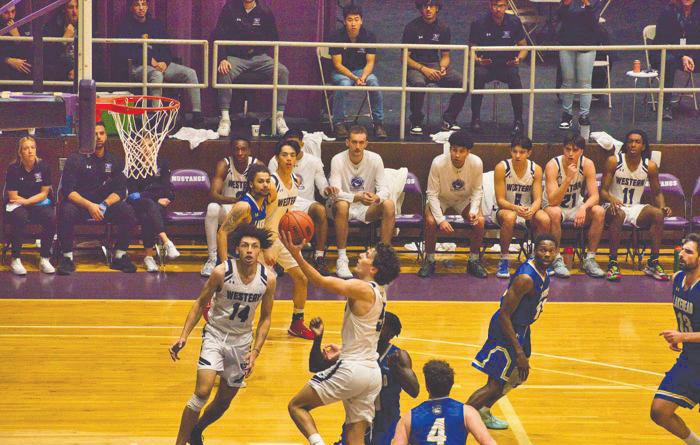
bounding and steals over the regular season.
The team’s star players have always praised the group’s talent and culture, but head coach Brad Campbell has focused on a “slow build” this season after the retirement of many veteran players. They just need to keep going.
WOMEN’S HOCKEY: IMPROVE THE POWERPLAY

The Mustangs women’s hockey team entered the season with one of the OUA’s best goaltenders — fourth-year Kaitlyn Booth. Fortunately for the team, Booth has continued her strong play throughout this season, averaging less than two goals against per game and saving almost 93 per cent of the shots she’s faced.
Western has only scored 25 goals in 18 games. Despite a strong goaltending performance from Booth, the Mustangs can’t find the back of the opposing team’s net and have been shutout six times this season.
It’s obvious the Mustangs scoring problems arise from their dormant powerplay, only clipping at 4.7 per cent. If Western would like to complement their star goaltender, they’ll need to find a way to take advantage of their opponents' mistakes down the stretch.
MEN’S HOCKEY: FIND MORE BALANCE
While the Mustangs men’s hockey team is sitting in the middle of a playo race between themselves and their west division rivals, they have lots of work left.
Part of the team’s six wins has been their fairly e ective scoring, but it’s been assisted by their de-

fencemen. Second-year defenceman Jake Gravelle and first-year defenceman Eric Van Impe lead the way with 21 and 19 points, respectively.
While it's always promising to have the back end chip in on o ence, the Mustangs’ goaltending and defensive prowess have stumbled. The team has allowed nearly four goals per game this season and third-year goaltender Dylan Myskiw has stopped less than 90 per cent of the shots he’s faced.
Moving forward, Western needs to find more scoring from their forwards, so their defencemen can be more e ective in their own zone — and pick better times to step up in the rush.
WOMEN’S VOLLEYBALL: DON’T GET COMPLACEN T
The Mustangs women’s volleyball team has been virtually unstoppable, having not lost a set since November 2022. The team has climbed to a thirdplace tie in the OUA standings.
So how can the Mustangs get any better? By not getting complacent.
While it’s important to be confident, Western must continue to improve their game in order to compete for a championship come the spring. The OUA is filled with talented women’s volleyball teams, including the 11–2 University of Waterloo Warriors and 11–2 McMaster University Marauders — both of which are on winning streaks of five games or more.
The Mustangs have solidified themselves as part of the contending group, but their last three matchups have come against the bottom three teams in the OUA. The Mustangs must beat teams like the Marauders and Brock University Badgers before bringing the championship trophy home to London.
MEN’S VOLLEYBALL: FIND SOME CONSISTENCY


In some ways similar to the women’s team, the Mustangs men’s volleyball team has feasted on the OUA’s “bottom-feeders” this season — not winning a match against a team with a winning record this season.
For Western, the story has repeated itself over — win one, lose one.
While they’ve competed against teams like the University of Guelph Gryphons and York University Lions, the Mustangs haven’t found points in the game’s key moments or most important sets.
The team has a knack for starting strong, but despite having won the first set in four of their five losses, the Mustangs have struggled as the game’s go along.
If Western would like to defeat the OUA’s most powerful teams, they’ll need to find some consistency in their game — particularly when push comes to shove in the third, fourth and even fifth sets.
The ‘slow build’: How our young men’s basketball is moving up
MILES BOLTON SPORTS EDITOR
In the midst of their up-and-down 2022–23 regular season, the Mustangs men’s basketball team has remained focused on one thing: performing as one.
The 2022 o season saw the departures of many of Western University’s veteran basketball players, including guards Omar Shiddo and Isaiah Familia, and forwards Anthony Zrvnar and Aaron Tennant.
With a high roster turnover and a young team — six players are in their first year of eligibility — the Mustangs have been working on transitioning their individual talents into on-court success.
“It's been interesting,” said head coach Brad Campbell after a win over the Laurentian University Voyageurs on Nov. 18, 2022.

“We're so young, it's funny. We evaluated things after COVID. It seems like a lot of teams got older, and we seemed to get younger, so there's going to be a process with getting younger and playing younger guys.”
Growing pains aren’t just a fact of life. Western struggled in the early part of the current Ontario University Athletics regular season and had a 4–5 record with one game left before the winter break.
But veteran players never doubted the team’s potential.
“Our talent is definitely there,” said fourth-year guard Jerric Palma. “It's just a matter of putting all the pieces together and working more as a cohesive unit.”
“There’s no doubt that we’ll be back with a winning record,” Palma added.
And Palma was right. With their win over the University of Waterloo Warriors on Jan. 13 — Western’s third consecutive victory — the young
Tyson Dunn drives to the basket, Dec. 2, 2022.
Mustangs have improved their regular season record to 7–5.
The team’s recent success can be attributed to individual standout performances and improving their team play. The Mustangs have made their way up the conference standings from nights like Palma’s 33 points against the University of Windsor Lancers on Jan. 7 and Jan. 13th’s triple-double from third-year guard Tyson Dunn against the Warriors.
“We needed everybody out there today,” said fifth-year forward Aryan Sharma after Jan. 13th's game. “We're a young team, but that's not an excuse, right? When we go out there, it's all level playing field. We know what we got to do in practice to prepare, and then it just comes down to being able to execute down the stretch.”
Standing next to Sharma, Dunn didn’t have much to add on the group’s mindset heading into the game.
“Yeah,” Dunn agreed with a smile. “Well said.”
The team isn't perfect. Their biggest hurdle to date has been defence and holding leads. In Jan. 13th's win, Western blew leads in the first and third
quarters, letting the winless Warriors claw back into the game multiple times.
The Mustangs are 13th in rebounding in the OUA, averaging 35.5 boards per game. More glaring is that they’re 15th in defensive rebounds, averaging 25.3 per game.
But continuous improvement is what the Mustangs feel will help them improve their defensive game.
“We continue to work on it every day,” Campbell said about the team’s defence. “And we'll continue to work on it in the new year.”
Over their current three-game win streak, Western’s rebounding and defensive play have improved, with the team averaging 25.3 defensive rebounds. Comparing that to their first two games of the regular season — back-to-back losses to the Lancers and Wilfrid Laurier University Golden Hawks — the team averaged just 18 defensive boards per game.
In the same time frame, Western has also improved their steals. In the past three games, the Mustangs have averaged eight steals per game, up from the 6.5 they averaged in the first week of the season.
Their improving defensive metrics speak to the players’ character.
Despite their youth, they’re constantly learning and improving to bring themselves to what Campbell says is a “high character group.”
“This group has belief in themselves,” Campbell said. “And when you have belief in yourself, it becomes a lot easier.”
Campbell also said the group’s character comes from their “compete level” and a refusal to quit on any given night.
“We've got some really good young players,” he added. “This team is going to continue to get better. It just doesn't happen overnight.”
“We have to have a slow build here,” he explained. “We got some things we don't do very well, and we're gonna have to work on those, but it's gonna be fun watching this team develop and grow as we continue to get better.”
Campbell’s players also credit the young squad’s ability to step up for each other in games. Dunn says roster turnover is natural and happens every year, but the young players have been stepping up.
“We all love each other on the court [and] o the court,” Sharma said earlier this season. “We play for one another, we battle for one another, we go to war for one another. So no matter who it is on the court, no matter what lineup we're throwing, we're just going to be together.”
Gearing up for the upcoming playo push, the Mustangs plan to continue what they’re doing, and not change the way they prepare for games.
“ We prepare the way we prepare and it doesn't really matter who we're playing against,” said Dunn.
Meanwhile, coach Campbell’s vision is focused on steadily improving with the OUA playo s around the corner.
“We're going to be a tough team to deal with by the end of the year and we want to be peaking by playo s,” Campbell said.
“It's a slow and steady build. We still have a young team and that build is going to take some time.”



SPORTS | P7
MASON LYN GAZETTE
It’s not you, it’s me
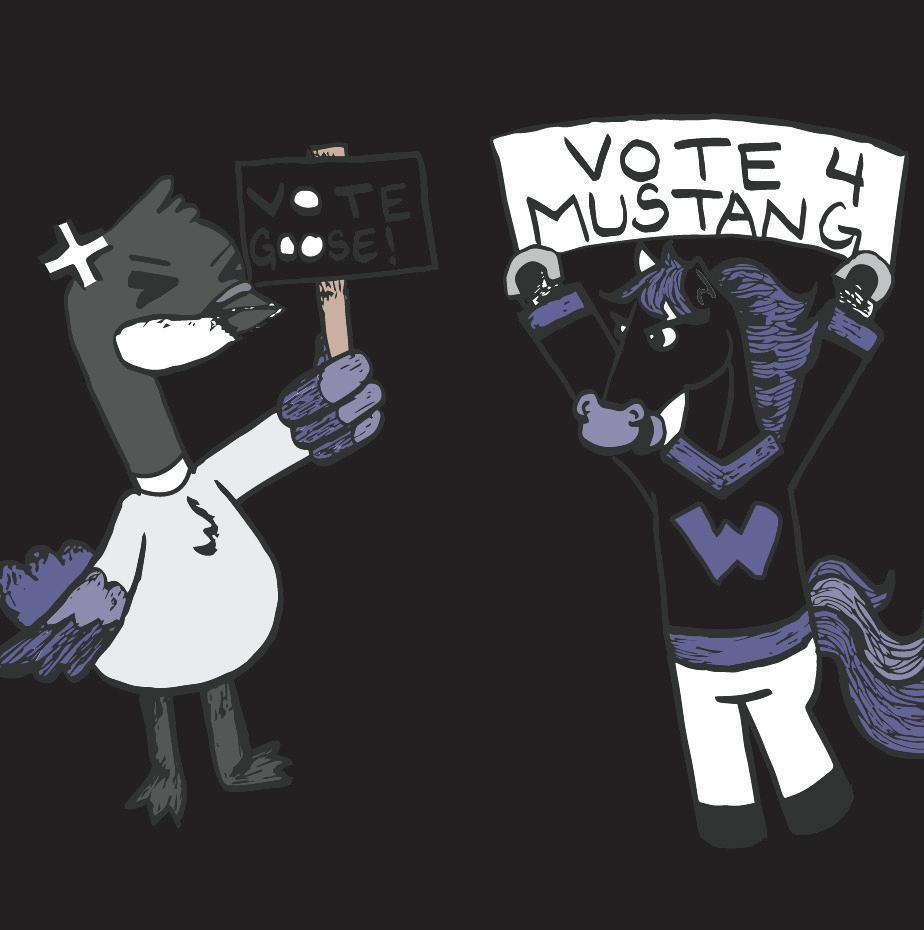 CAT TANG CULTURE EDITOR
CAT TANG CULTURE EDITOR




Dear readers, I think we need to break up.
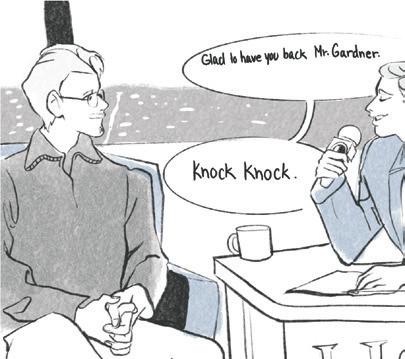
It’s not you, it’s me. I’ve changed a lot since this column started, which is why I think we both need to take some time to see other people — or, in my case, write other articles.





The reason I’ve decided to end the column is because I’ve realized that dating isn’t a priority for me right now. I’m not interested in looking for a partner, and while I didn’t have a horrible time on any of my dates, it’s not how I want to spend my time.
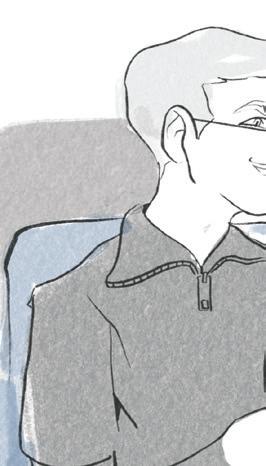
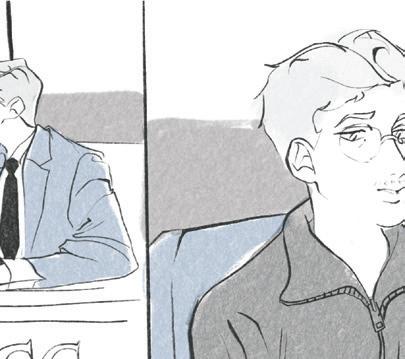

I realized I would much rather spend my weekend afternoons training my Pokémon on my Nintendo Switch than talking to an Ivey student about what their career goals are — even if it is over a free latte.
If I were to keep going on dates, it would only be for the sake of this column — and while more than a little tempting, that is not a mindset I’m willing to walk into the new year with.

My online dating experience has been worthwhile, and I have learned a lot. Perhaps the most valuable takeaway I’ve gained is that male attention can be cheap, abundant and unrewarding.




As a young, heterosexual woman, I’d never received a lot of male attention — whether in high school or earlier in university — so it always seemed like something special. I thought that if Tommy from geography would notice me, all of my problems would magically disappear.
Now that I’ve been wooed by men of all kinds on a variety of di erent apps, surprisingly, my problems are still the same. I still struggle to wake up for my 9:30 a.m. classes, University Students’ Council president Ethan Gardner hasn’t replied to my fan mail and The Spoke line is still far too long.


But I do feel a lot more confident than I did when I first started this column. I have a better idea of what I’m looking for in a partner, better expectations for how I want to be treated and know that I will find romantic love eventually — when I want to.


Can we still stay friends?
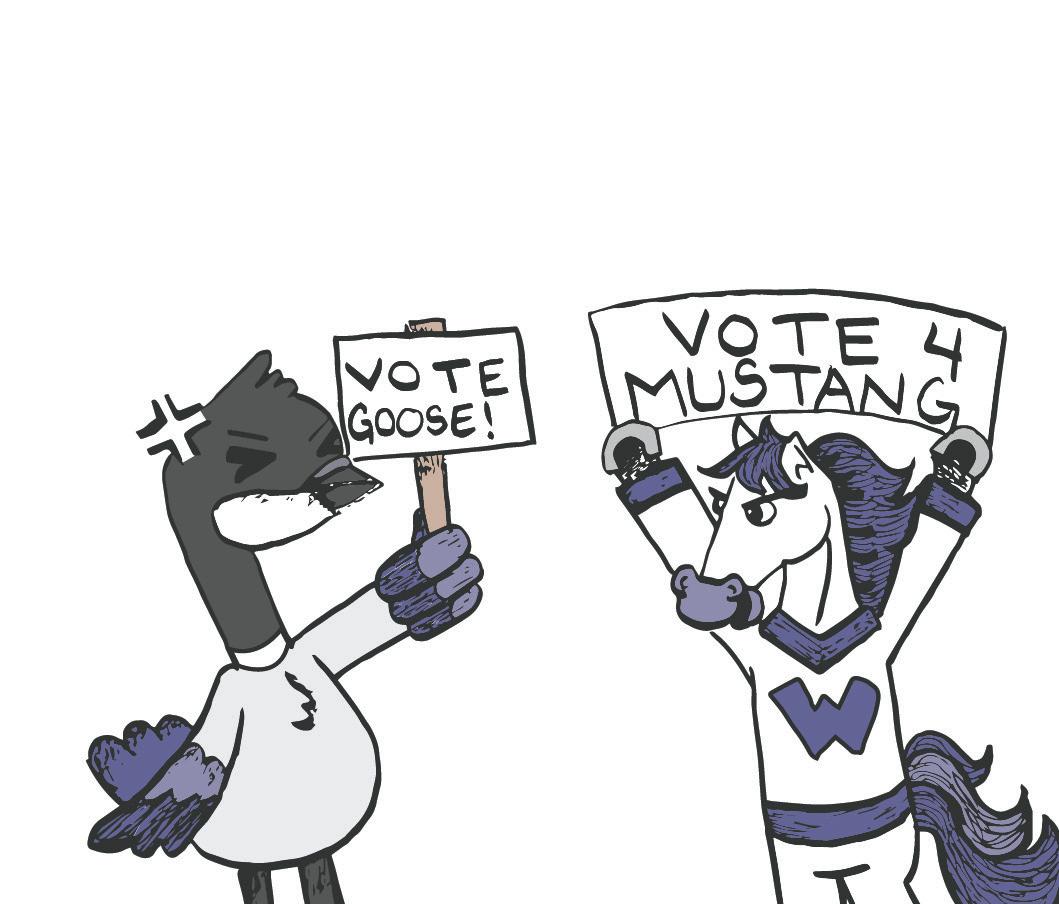
Review: Controlled Damage educates and inspires with tale of a Canadian hero
DANIELLE PAUL CULTURE EDITOR

ViolaDesmond is a Canadian hero. But she was also a real person with family, friends and dreams, which were cut short due to racism — and that is exactly what Controlled Damage portrayed.
Controlled Damage is a play featuring state-ofthe-art sets, a well-researched script and important symbolic messages about racist oppression in Canada.
In 1946, Desmond attended a movie at the Roseland Theatre. After sitting in the whites-only section, she was physically removed from the theatre and arrested. Her act of resistance paved the way for the Canadian civil rights movement and, in 2018, was honoured on the $10 bill.
The play begins early in Desmond’s life, and shows how she became a teacher and successful business woman in her Halifax community. In the later half of the play, the audience watches Desmond take her stand against racism and learns the fallout of this act for her personal life.

The set was impressive, with electronic screens around center stage and a huge box which took up the most space on the stage. Beck Lloyd, who played Desmond, was confined to the symbolic box for every scene. The only time Lloyd left the box was in the scene of Desmond’s death.
One of my favourite elements of the play was the music. Controlled Damage incorporated gospel and folk music, a perfect ode to the character of Desmond.
Controlled Damage was a beautiful play that made sure to tell Desmond’s whole story and show not only her heroism, but how her resistance changed the rest of her life.
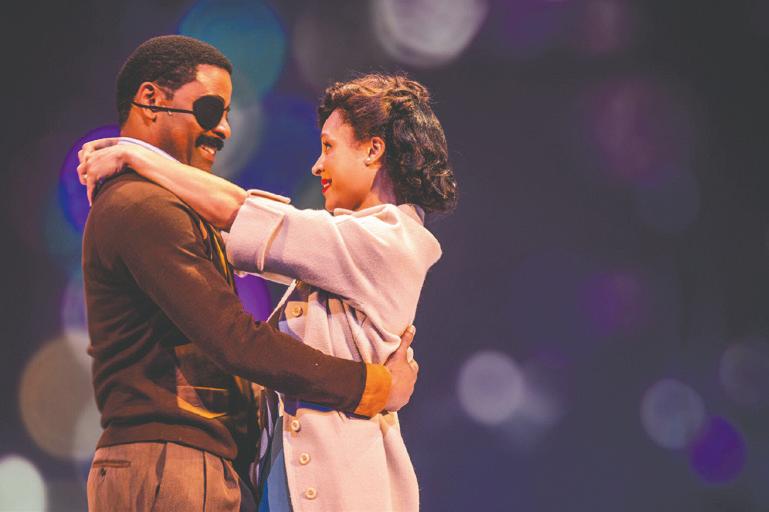
Controlled Damage is playing at the Grand Theatre until Jan. 29. Tickets can be purchased on their website.
CAMILLE SEYRAT GAZETTE


While the plot in the first act felt rushed, speeding through Desmond’s early years, as the play progressed, I found it much easier to understand and follow along. However, I think it’s important that theatre-goers know the story of Desmond before the play to get the most out of the production.
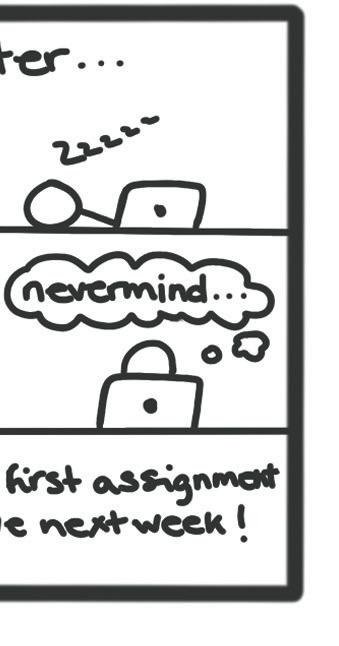

CULTURE | P8
COURTESY OF DAHLIA KATZ Beck Lloyd and Stewart Adam McKensy in the Grand's production of Controlled Damage.
COURTESY OF DAHLIA KATZ Beck Lloyd and Kaylee Harwood in the Grand's production of Controlled Damage.
SOPHIE SMITH GAZETTE
CAMILLE SEYRAT GAZETTE
Email your comics to comics@westerngazette.ca or come to UCC 263 and ask about volunteering for our Graphics section!
LANEY ARMSTRONG GAZETTE









































 LAUREN MEDEIROS CULTURE EDITOR
LAUREN MEDEIROS CULTURE EDITOR











































 CAT TANG CULTURE EDITOR
CAT TANG CULTURE EDITOR



























